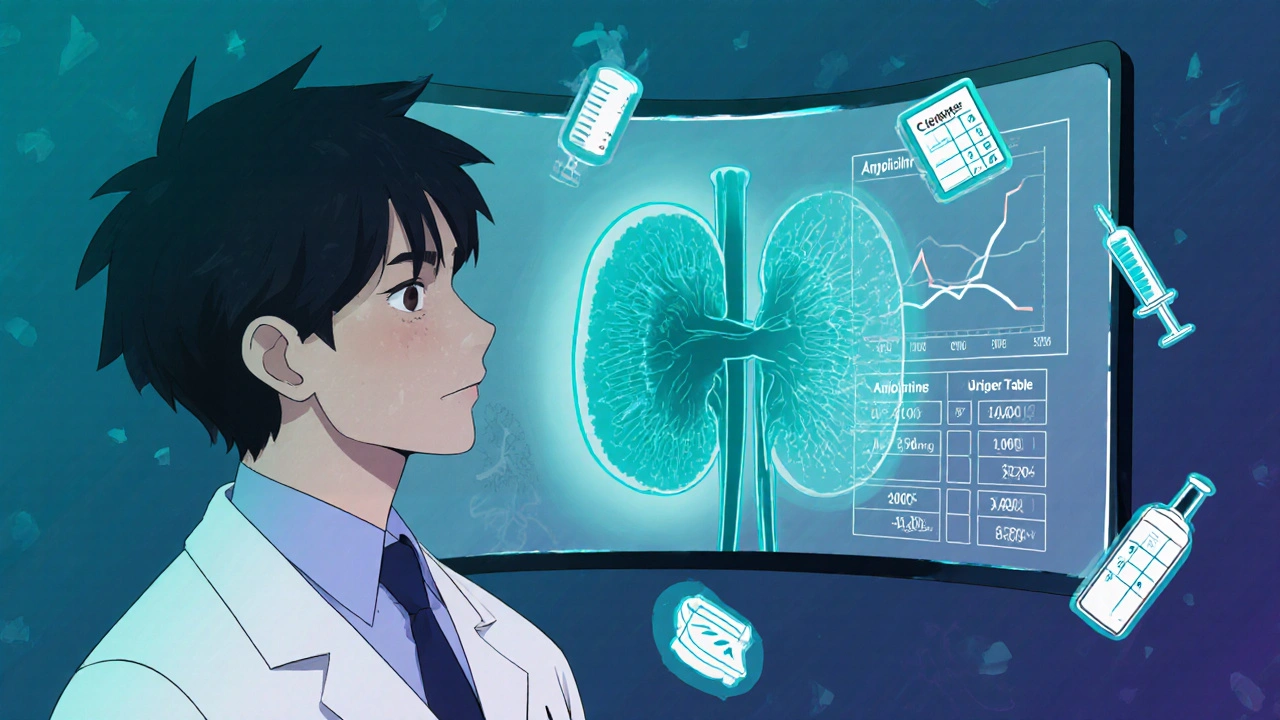
Quick Takeaways
- AMPICILLIN remains a first‑line beta‑lactam for many bacterial infections, but dosage and monitoring must be adjusted for immunocompromised patients.
- Renal function, neutropenia level, and concurrent chemotherapy heavily influence safe dosing.
- Therapeutic drug monitoring (TDM) is not routine for ampicillin, yet measuring trough levels can help avoid toxicity in patients with altered pharmacokinetics.
- Consider alternative agents when beta‑lactamase‑producing organisms are likely.
- Watch for drug interactions with immunosuppressants such as tacrolimus or mycophenolate.
Infections are the leading cause of hospital‑acquired complications for people whose immune systems are compromised. Whether the weakness stems from chemotherapy, a stem‑cell transplant, HIV/AIDS, or a primary immunodeficiency, the choice of antibiotic can tip the balance between recovery and a life‑threatening setback. This guide explains how to use Ampicillin a broad‑spectrum penicillin derivative active against many Gram‑positive and some Gram‑negative bacteria safely in these high‑risk groups.
Understanding the Patient Population
Immunocompromised patient any individual with a reduced ability to mount an effective immune response due to disease, medication, or medical procedure is not a single entity. The main categories that affect antibiotic decisions are:
- Neutropenia an absolute neutrophil count (ANC) below 500 cells/µL, often caused by chemotherapy.
- Stem cell transplant recipients patients who have undergone allogeneic or autologous transplantation and are on post‑transplant immunosuppression.
- People living with HIV/AIDS especially those with CD4 counts under 200 cells/µL.
- Patients on chronic immunosuppressive therapy such as tacrolimus, azathioprine, or mycophenolate for organ transplantation or autoimmune disease.
Each subgroup has distinct infection patterns, organ‑function challenges, and drug‑interaction profiles that shape ampicillin use.
Why Ampicillin Still Matters
Although newer agents exist, Ampicillin belongs to the penicillin class and retains activity against Enterococcus, Listeria, and certain Streptococcus species. Its advantages include:
- Low cost and wide availability, essential for inpatient formularies and low‑resource settings.
- Predictable pharmacokinetics in patients with normal renal function.
- Well‑documented safety profile when dosing guidelines are followed.
However, its beta‑lactam ring is vulnerable to degradation by beta‑lactamase enzymes produced by many resistant bacteria, and it can accumulate in renal impairment-both issues that become magnified in immunocompromised hosts.
Adjusting Dose for Renal Function
Renal clearance accounts for roughly 80 % of ampicillin elimination. In patients with reduced creatinine clearance (CrCl), the standard 2 g every 6 hours regimen can lead to serum concentrations that exceed the therapeutic window, increasing the risk of neurotoxicity and interstitial nephritis.
Use the following simplified table to guide dosing based on estimated CrCl (Cockcroft‑Gault):
| CrCl (mL/min) | Typical infection | Adjusted dose | dosing interval |
|---|---|---|---|
| > 60 | Penetrating soft‑tissue infection | 2 g | Every 6 h |
| 30‑60 | Urinary tract infection | 1.5 g | Every 8 h |
| 10‑30 | Enterococcal endocarditis | 1 g | Every 12 h |
| <10 | Severe sepsis (if necessary) | 500 mg | Every 12 h |
For patients on dialysis, give a post‑dialysis dose of 500 mg-1 g, then resume the adjusted schedule.

Special Considerations for Neutropenic Fever
Neutropenic fever demands rapid, empiric broad‑spectrum coverage. While many centers favor anti‑pseudomonal beta‑lactams (e.g., cefepime), ampicillin can be added to target Listeria and Enterococcus when these organisms are suspected.
Guideline‑based regimen:
- Base therapy: anti‑pseudomonal beta‑lactam (cefepime 2 g q8h).
- Adjunct ampicillin: 2 g q6h (unless renal impairment dictates adjustment).
- Stop ampicillin after 48 h if cultures are negative for ampicillin‑susceptible organisms.
Therapeutic drug monitoring isn’t typical for ampicillin, but in profound neutropenia (<100 cells/µL) with multi‑organ failure, measuring trough levels can help prevent neurotoxicity-especially when concomitant drugs like carbapenems are used.
Drug Interactions You Can’t Ignore
Immunosuppressants often share renal excretion pathways with ampicillin, creating competition that can raise levels of both drugs.
- Tacrolimus: ampicillin may increase tacrolimus serum concentrations by 20‑30 %. Check tacrolimus troughs after the first 24 h of ampicillin.
- Mycophenolate mofetil: no major PK interaction, but combined GI upset can impair oral absorption of both agents.
- Vancomycin: synergistic kidney toxicity is possible; monitor serum creatinine closely if both are given.
Adverse Effects and Monitoring
Most side effects are predictable:
- Allergic reactions: rash, urticaria, anaphylaxis (especially in patients with a history of penicillin allergy).
- GI upset: nausea, diarrhea; probiotic use may reduce Clostridioides difficile risk.
- Neurotoxicity: confusion, seizures-more common when serum levels exceed 100 µg/mL, usually in renal failure.
- Hematologic: rare cases of neutropenia and thrombocytopenia; monitor CBC if therapy extends beyond 7 days.
Routine labs for patients on ampicillin should include:
- Baseline and daily serum creatinine (or eGFR) when renal dose reduction is in place.
- CBC on day 3 and day 7 for prolonged courses.
- Therapeutic drug levels only if neurotoxic symptoms arise or if the patient is on high‑dose continuous infusion.
When to Switch or Stop Ampicillin
De‑escalation is a cornerstone of antimicrobial stewardship. Consider alternative agents when:
- Culture data show a beta‑lactamase‑producing organism resistant to ampicillin.
- Patient develops a confirmed penicillin allergy during therapy.
- Renal function deteriorates abruptly, making dose adjustments impractical.
- Clinical response is lacking after 72 h of appropriate dosing.
For infections caused by Enterococcus faecalis with high-level aminoglycoside resistance, linezolid or daptomycin may be a safer choice.
Practical Checklist for Clinicians
- Confirm the patient’s immunocompromised category (neutropenia, transplant, HIV, immunosuppressants).
- Calculate CrCl and select the appropriate ampicillin dose.
- Review medication list for tacrolimus, mycophenolate, and nephrotoxic agents.
- Obtain baseline labs: CBC, serum creatinine, liver enzymes.
- Order cultures before the first dose, then reassess at 48 h.
- Document any allergy history; consider skin testing if uncertain.
- Monitor for neuro‑psychiatric changes-especially in renal failure.
- De‑escalate or switch therapy based on culture results and clinical response.
Frequently Asked Questions
Can I give ampicillin to a patient with a known penicillin allergy?
No. Cross‑reactivity between penicillins and cephalosporins can be as high as 10 %. If the allergy is severe (anaphylaxis), avoid ampicillin completely and choose a non‑beta‑lactam agent.
Is therapeutic drug monitoring required for ampicillin?
Routine TDM is not recommended for most patients. However, in severe renal impairment, prolonged high‑dose infusions, or when neurotoxicity emerges, checking a trough level can guide dose reduction.
How does ampicillin compare to amoxicillin for immunocompromised patients?
Both are penicillins, but ampicillin has better IV formulation options, making it preferable for severe infections requiring inpatient therapy. Amoxicillin is oral‑only and less flexible for dose adjustments.
What organisms are reliably covered by ampicillin in neutropenic patients?
Enterococcus spp., Listeria monocytogenes, and susceptible Streptococcus species. It does not cover Pseudomonas, many Enterobacteriaceae that produce beta‑lactamases, or MRSA.
Should I adjust ampicillin dose for a patient on continuous renal replacement therapy (CRRT)?
Yes. CRRT clears ampicillin similarly to intermittent dialysis. A typical approach is 500 mg‑1 g IV every 8 hours, with a post‑filter dose if the filter is changed.
Using ampicillin wisely in immunocompromised patients means balancing aggressive infection control with the delicate physiology of a weakened host. By tailoring dose to renal function, watching for drug interactions, and stepping back when cultures say the drug isn’t needed, clinicians can keep the antibiotic effective while minimizing harm.



When you’re dealing with immunocompromised patients, the first thing to check is the creatinine clearance before picking a dose of ampicillin. If the CrCl is above 60 mL/min you can stick with the standard 2 g every 6 hours, but once you dip below that, you need to drop both the amount and the frequency. For a CrCl of 30‑60 mL/min, 1.5 g every 8 hours usually does the trick, while a CrCl under 30 mL/min often calls for 1 g every 12 hours. This simple adjustment can keep neurotoxicity at bay and protect the kidneys. Always pair the dose change with a quick review of the latest labs, especially if the patient is on nephrotoxic chemo agents.
Low‑dose ampicillin isn’t enough for neutropenic fevers; you must hit therapeutic levels.
Despite what the guidelines flaunt, the lack of routine therapeutic drug monitoring for ampicillin is a glaring oversight in many oncology wards. Clinicians often assume the drug’s PK are “predictable,” yet immunosuppressed patients have wildly variable volumes of distribution and clearance. Ignoring trough levels means you’re sailing blind, and that invites neurotoxicity or sub‑therapeutic exposure that can let resistant bugs thrive. The data on ampicillin neurotoxicity in renal impairment is not just anecdotal-it’s documented in multiple case series. If you’re already drawing blood for cytokine panels, slipping in a simple ampicillin trough costs pennies but could save a life.
Let me tell you, I once swapped a patient’s ampicillin regimen without telling the attending, and the outcome was a textbook case of rapid clearance due to aggressive hydration. It turned out the pharmacist’s dosing calculator was off because the patient’s weight was entered in pounds instead of kilograms. The lesson here is that every team member needs to double‑check the units; otherwise you’re just feeding the system more noise. Don’t be shy about flagging those tiny errors- they compound fast in immunocompromised settings.
Choosing an alternative to ampicillin because of beta‑lactamase worries is not just a minor tweak; it’s a dramatic shift that can upend the whole antimicrobial stewardship plan. If you pivot to a carbapenem without proper justification, you’re feeding the rise of super‑bugs like a feasting dragon. Moreover, the cost explosion for newer agents can cripple a hospital’s budget, especially in low‑resource settings where ampicillin’s affordability is a lifeline. So weigh the beta‑lactamase risk against the downstream fallout before you leap.
The structural vulnerability of the β‑lactam ring to hydrolysis by extended‑spectrum β‑lactamases necessitates a rigorous evaluation of local antibiograms prior to ampicillin deployment. In institutions where ESBL‑producing Enterobacteriaceae predominate, empiric ampicillin monotherapy may be deemed untenable, and synergy with a β‑lactamase inhibitor becomes obligatory. Furthermore, pharmacodynamic targets such as %fT>MIC must be achieved, which often requires dose escalation beyond conventional regimens in the presence of altered renal function. A meticulous juxtaposition of MIC data against achievable serum concentrations is indispensable for optimal therapeutic outcomes.
It’s great that you’ve included the CrCl‑based dosing table; having that visual reference makes it easier for clinicians to adjust on the fly. Just remember to verify the patient’s weight and serum creatinine each shift, because even small fluctuations can shift the CrCl category. If you notice the patient’s urine output declining, consider a bedside estimated GFR to double‑check the numbers before the next dose. Keep the table handy in the unit’s binder, and encourage the nursing staff to ask the pharmacy when in doubt.
Yo, stop whining about ampicillin being old-this cheap pill saves lives while the pharma giants push pricey “miracle” drugs that hardly work any better. If you’re scared of beta‑lactamase, just throw in a cheap clavulanate combo and you’re golden. Don’t be a sheep following the latest hype; stick to what’s proven and wallet‑friendly.
Working together across the pharmacy, nursing, and infectious disease teams really makes dosing adjustments smoother for our immunocompromised patients. When the pharmacist flags a potential drug‑drug interaction early, we can pre‑emptively tweak the ampicillin schedule and avoid toxicity. Sharing the latest lab trends in a quick huddle keeps everyone on the same page, and patients end up with safer, more effective therapy.
Monitoring ampicillin levels in immunocompromised patients is a nuanced process that goes far beyond simply checking a serum concentration. First, you need to establish a baseline renal function, because even a mild rise in creatinine can dramatically alter the drug’s half‑life. Next, collect trough samples just before the next dose to capture the lowest point, which is the most informative for assessing potential toxicity. If the trough is consistently above the upper therapeutic window, consider extending the dosing interval rather than outright dose reduction, as this preserves peak concentrations needed for bacterial killing. On the other hand, sub‑therapeutic troughs may signal that the patient’s volume of distribution has increased due to aggressive hydration or underlying inflammation, warranting a dose bump. It’s also crucial to note any concurrent nephrotoxic agents, such as amphotericin B or certain chemotherapy drugs, since they can exacerbate renal impairment and push ampicillin levels higher. Regularly updating the dosing calculator with the most recent lab values prevents the “set‑and‑forget” trap that many clinicians fall into. Engaging the interdisciplinary team-pharmacists, clinicians, and nurses-in reviewing these levels ensures that adjustments are made promptly and safely. Remember that neurotoxicity, while rare, manifests as seizures or altered mental status, especially when troughs exceed 100 µg/mL, so any neurologic change should trigger an immediate reassessment of the ampicillin regimen. In settings where therapeutic drug monitoring isn’t available, clinicians can rely on surrogate markers like rising BUN and creatinine, coupled with vigilant clinical observation, to catch early signs of accumulation. Finally, document every dose change, the rationale behind it, and the patient’s response; this creates a valuable record for future cases and contributes to institutional knowledge. By treating ampicillin monitoring as a dynamic, patient‑specific protocol rather than a static checklist, we can maximize efficacy while minimizing harm for our most vulnerable patients.
One could argue that every dose of ampicillin is a tiny negotiation between the body’s defenses and the microbial world 🌍. When we adjust the regimen for an immunocompromised host, we’re essentially re‑balancing that delicate scale ⚖️. It’s fascinating how a simple change in interval can tip the scales toward healing or toxicity. So let’s respect the chemistry, honor the patient’s fragility, and remember that stewardship is a moral duty 😊.